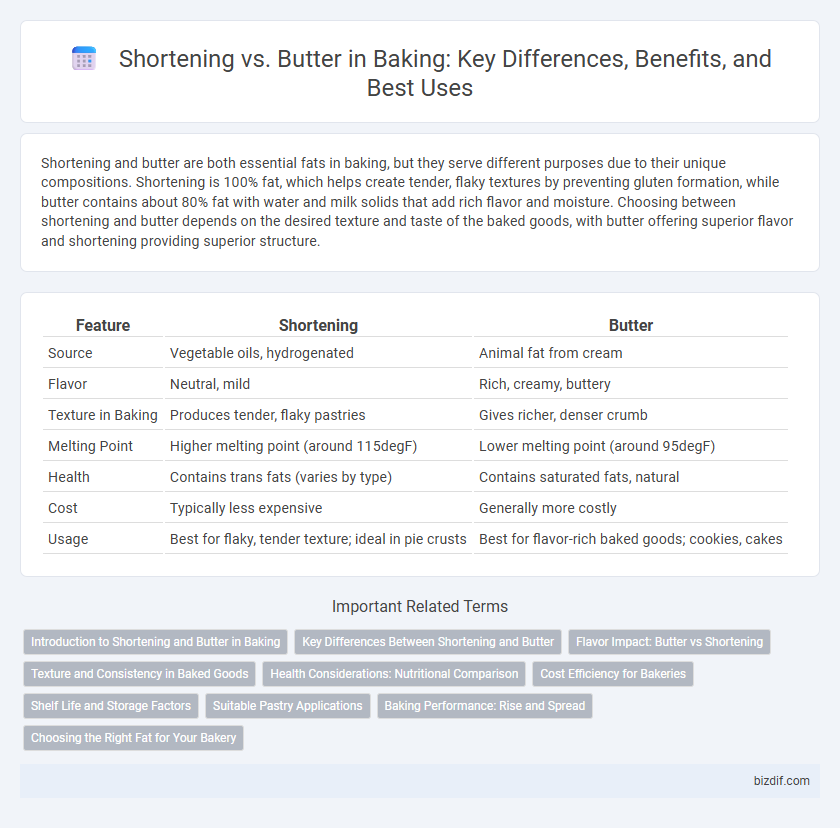Shortening and butter are both essential fats in baking, but they serve different purposes due to their unique compositions. Shortening is 100% fat, which helps create tender, flaky textures by preventing gluten formation, while butter contains about 80% fat with water and milk solids that add rich flavor and moisture. Choosing between shortening and butter depends on the desired texture and taste of the baked goods, with butter offering superior flavor and shortening providing superior structure.
Table of Comparison
| Feature | Shortening | Butter |
|---|---|---|
| Source | Vegetable oils, hydrogenated | Animal fat from cream |
| Flavor | Neutral, mild | Rich, creamy, buttery |
| Texture in Baking | Produces tender, flaky pastries | Gives richer, denser crumb |
| Melting Point | Higher melting point (around 115degF) | Lower melting point (around 95degF) |
| Health | Contains trans fats (varies by type) | Contains saturated fats, natural |
| Cost | Typically less expensive | Generally more costly |
| Usage | Best for flaky, tender texture; ideal in pie crusts | Best for flavor-rich baked goods; cookies, cakes |
Introduction to Shortening and Butter in Baking
Shortening, a solid fat made from vegetable oils, offers a higher melting point and contributes to a tender, flaky texture in baked goods. Butter, derived from cream, imparts rich flavor and moisture while enhancing browning due to its water content. Understanding the unique properties of shortening and butter helps bakers choose the right fat to achieve desired texture and flavor in pastries, cookies, and cakes.
Key Differences Between Shortening and Butter
Shortening, made from hydrogenated vegetable oils, is solid at room temperature and contains no water, giving baked goods a lighter, flakier texture and extended shelf life. Butter, sourced from cream and containing about 80% fat with water and milk solids, imparts richer flavor and moisture but results in denser baked products. The choice between shortening and butter affects texture, flavor, and nutritional profile, with shortening favoring tenderness and stability, while butter enhances taste and browning.
Flavor Impact: Butter vs Shortening
Butter delivers a rich, creamy flavor with natural dairy notes that enhance baked goods' taste, creating a more complex and indulgent profile. Shortening provides a neutral taste, allowing other ingredients' flavors to stand out without adding richness or depth. Choosing butter results in a more flavorful and aromatic product, while shortening emphasizes texture over taste.
Texture and Consistency in Baked Goods
Shortening produces a tender, flaky texture in baked goods due to its 100% fat content and higher melting point, which helps maintain shape and structure during baking. Butter contributes rich flavor and moisture but creates a denser, softer crumb because of its water content and lower melting point. Choosing between shortening and butter directly affects the consistency, with shortening ideal for crispness and butter preferred for flavorful, moist textures.
Health Considerations: Nutritional Comparison
Shortening contains zero trans fats if labeled non-hydrogenated but often lacks essential vitamins found in butter, such as vitamins A and E. Butter provides beneficial nutrients like fat-soluble vitamins and conjugated linoleic acid (CLA), which supports heart health but includes higher levels of saturated fat and cholesterol. Choosing between shortening and butter depends on balancing the desire for improved lipid profiles against obtaining natural vitamins and antioxidants.
Cost Efficiency for Bakeries
Shortening offers superior cost efficiency for bakeries due to its lower price per unit and longer shelf life compared to butter. This solid fat maintains product consistency and moisture, reducing waste and production costs. While butter imparts richer flavor, its higher cost and perishability often make shortening a more economical choice for large-scale baking operations.
Shelf Life and Storage Factors
Shortening typically has a longer shelf life than butter due to its higher saturated fat content and lower moisture level, which helps prevent spoilage. Butter requires refrigeration to maintain freshness and prevent rancidity, often lasting up to one month when properly stored. In contrast, shortening can be stored at room temperature for several months without significant degradation in quality.
Suitable Pastry Applications
Shortening is ideal for flaky and tender pastries like pie crusts and biscuits due to its 100% fat content and higher melting point, which creates distinct layers without melting quickly. Butter offers rich flavor and moisture, making it suitable for pastries like croissants and puff pastry where taste and browning are prioritized. For optimal results, choose shortening for structure and flakiness, while butter enhances flavor and aroma in baked goods.
Baking Performance: Rise and Spread
Shortening provides superior rise and controlled spread in baked goods due to its higher melting point, which helps maintain dough structure during baking. Butter, containing water and milk solids, contributes to more spread and less rise, resulting in a tender texture but less volume. For recipes requiring maximum lift and defined shape, shortening often outperforms butter in achieving consistent rise and reduced spread.
Choosing the Right Fat for Your Bakery
Choosing the right fat in your bakery impacts texture, flavor, and shelf life of baked goods. Shortening provides a neutral taste and creates tender, flaky pastries with longer freshness, while butter offers rich flavor and a creamy crumb but has a lower melting point, affecting structure. Assessing the desired product qualities and baking technique helps determine whether shortening or butter is optimal for your recipes.
Shortening vs Butter Infographic

 bizdif.com
bizdif.com